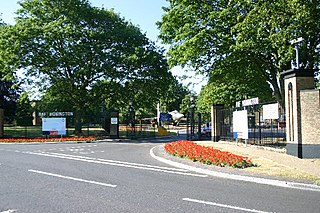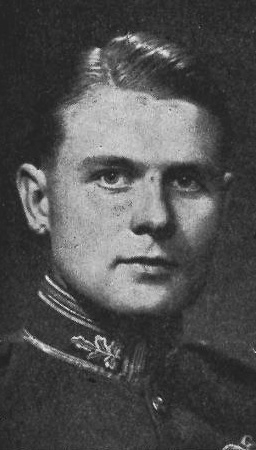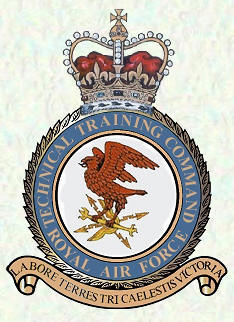
The former Royal Air Force Far East Air Force, more simply known as RAF Far East Air Force, was the Command organisation that controlled all Royal Air Force assets in the east of Asia. It was originally formed as Air Command, South East Asia in 1943 during the Second World War. In 1946, this was renamed RAF Air Command Far East, and finally Far East Air Force in June 1949.

Royal Air Force Abingdon, or more simply RAF Abingdon, is a former Royal Air Force station near Abingdon, Oxfordshire. It is now known as Dalton Barracks and is used by the Royal Logistic Corps.

Royal Air Force Honington or more simply RAF Honington is a Royal Air Force station located 6 mi (9.7 km) south of Thetford near Ixworth in Suffolk, England. It was used as a bomber station during the Second World War and through the Cold War, hosting Handley Page Victors and Hawker Siddeley (Blackburn) Buccaneers. RAF Honington has been the RAF Regiment depot since 1994.

Ministry of Defence St Athan or MOD St Athan, formerly known as Royal Air Force St Athan, or more simply RAF St Athan, is a large Ministry of Defence unit near the village of St Athan in the Vale of Glamorgan, southern Wales.

No. 3 Group RAF of the Royal Air Force was an RAF group first active in 1918, again between 1923 and 1926, then as part of RAF Bomber Command from 1936 to 1967, and recently part of RAF Strike Command from 2000 until it disbanded on 1 April 2006.

Support Command was a command of the Royal Air Force between 1973 and 1994. The headquarters was located at RAF Brampton in Cambridgeshire.

Marshal of the Royal Air Force Samuel Charles Elworthy, Baron Elworthy, was a New Zealand-born senior officer in the Royal Air Force. He served as commander of a squadron of Blenheim bombers and then as a station commander during the Second World War. He became Chief of the Air Staff in the mid-1960s and implemented the cancellation of the TSR-2 strike aircraft and the HS681 military transport aircraft programmes. He also became Chief of the Defence Staff in which role he oversaw the evacuation from Aden in November 1967 and had to respond to the growing crisis in Northern Ireland in the late 1960s.

Air Chief Marshal Sir Kenneth Brian Boyd Cross, was a senior Royal Air Force commander. He was commonly known as Bing.

Training Command was the Royal Air Force's command responsible for flying and ground training from 1936 to 1940 and again from 1968 to 1977. Training Command was formed from RAF Inland Area on 1 May 1936 and absorbed into RAF Support Command on 13 June 1977. From 27 May 1940 to 1 June 1968, Training Command did not exist as its functions were split into Flying Training Command and Technical Training Command.

No. 22 Group Royal Air Force is one of six groups currently active in the Royal Air Force (RAF), falling under the responsibility of Deputy Commander-in-Chief (Personnel) in Air Command. Its previous title up until 2018 was No. 22 (Training) Group. The group is responsible for RAF training policy and controlling the Royal Air Force College and the RAF's training stations. As such, it is the direct successor to Training Group. 22 Group provides training to all three service branches of the British Armed Forces; namely the Royal Air Force, the Royal Navy, and the British Army.

Balloon Command was the Royal Air Force command which was responsible for controlling all the United Kingdom-based barrage balloon units during the Second World War.

Air Chief Marshal Sir Frederick Rosier, was a senior Royal Air Force commander.

Flying Training Command was an organization of the Royal Air Force; it controlled flight training units. The command's headquarters were at RAF Shinfield Park, Reading in Berkshire.
Air Headquarters East Africa was a command of the British Royal Air Force (RAF) formed on 19 October 1940 by expanding AHQ RAF Nairobi. On 15 December 1941, the command was reduced to Group status as No. 207 Group. On 16 November 1942, Air H.Q. East Africa was reformed by raising No. 207 Group back to Command status again.
Air Marshal Sir Reginald Edward Wynyard Harland, was a senior Royal Air Force commander.

Air Marshal Sir Patrick Hunter Dunn, was a Scottish Royal Air Force officer who served as Air Officer Commanding-in-Chief of Flying Training Command from 1964 to 1966.

Technical Training Command was an organization within the Royal Air Force which controlled units responsible for delivering aircraft maintenance training and other non-flying training, initially in Berkshire and then in Cambridgeshire.

Southern Area Command was one of several geographically based commands raised by the Royal Australian Air Force (RAAF) during World War II. It was formed in March 1940, and initially controlled units located in Victoria, Tasmania, South Australia and southern New South Wales. Headquartered in Melbourne, Southern Area Command was responsible for air defence, aerial reconnaissance and protection of the sea lanes within its boundaries. From 1942 its operational responsibilities excluded New South Wales.
At the end of the Cold War in 1989, the Royal Air Force (RAF) structure was as follows:
















